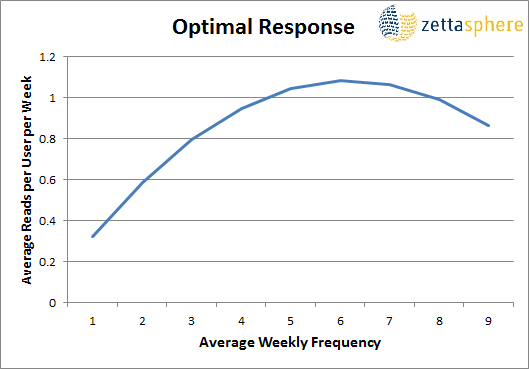How to Manage an Increase in Email Frequency

In today’s society, many of us suffer from too much of a good thing. We’ve got supersized foods, information overload and overstuffed email inboxes. What’s an email marketer to do?
The good news is that, while you might think you’re inundating your customers and prospects with emails, you may actually be under-emailing them.
When it comes to email marketing, less is not always more.
If you’re playing it conservatively, you could be missing out on great marketing opportunities by sending too few emails to your customers and prospects.
Take a lesson from the holiday season, when many online (and offline) retailers bombard their lists with email offers. For some retailers, it’s daily or (gasp) even more often. The point is, they know their what their customers are looking for and they deliver.
Don’t be afraid to communicate on a regular basis.
Truth is, we usually only hear from recipients who want to receive fewer emails. How often have you received requests to send more emails?
How do you determine the right frequency for your list?
Set the stage
Simply sending a vanilla “welcome” message doesn’t cut it anymore. Use the subscription box (or lead capture form) to first sell the value of your emails and follow through with a welcome series which proves the value and sets their expectations.
Start with best practices but get creative and be clear when opting in subscribers to your email list. When you do, your recipients truly want to receive email communications from your company.
Monitor opt-out rates
If you notice a spike in opt-outs, take a look at the frequency of your email campaigns during that time period. Then, if you see a correlation with higher email frequency, dial it back until the opt-outs level off.
Once they have, you can slowly increase the frequency of your emails.
Conversely, if opt-out rates are consistently low, experiment with increasing the frequency of your emails.
Failure to communicate important offers, news and events to your recipients could also result in opt-outs.
People have signed up to receive the inside scoop, so to speak, from your business or organization.
Examples include:
- Special offers and promotions (Email should mirror those on your website; don’t let your recipients find out about these first from online deal sites.)
- New products or services (If it’s announced in a news release, make sure you email your customers and prospects about it.)
- New hires, appointments, promotions (Your emails should coincide with or precede sharing these with industry publications and sites.)
- New website features or redesigns (People are creatures of habit; they don’t like unwelcome surprises when they come to your site.)
- Product recalls (Don’t let your customers wait until it hits the media.)
The bottom line is that if your recipients learn about your company’s offers, news and events elsewhere first, they will unsubscribe. Period.
Segment your list
When people sign up for emails, give them an option for email frequency. Set up a page on your website so subscribers can change their email preferences.
Use those preferences to segment your lists.
Have subscribers eager to hear from you on a daily basis? Mail away!
For subscribers who want fewer emails, send them only your most powerful campaigns.
Check out the competition
Sign up for competitors’ emails (don’t use your business email address, as companies often block competitors’ emails from their lists) and note their frequency.
Are they flooding your inbox? Are their emails few and far between? Find out where the opportunities lie and capitalize on them.

There is an optimal email frequency for your brand, and it is worth to find out what that is. Tim Watson explains on his site that 6.21 a week might be the best frequency for some brands.
Key email frequency takeaways
By emailing your list frequently, you keep your brand top of mind. So don’t be afraid to communicate regularly – and often – with your customers and prospects. Let the value and revenue drive your thinking, not fear.
They just might thank you for it.
- 5 Alternative Email Calls-to-Action - February 7, 2023
- Ignoring Usability When Selecting an Email Service Provider is a Giant Waste of Money - May 17, 2022
- Email Marketing: Master Basics Before Bodacious, Please! - April 21, 2020

2 Comments
by Dewane Mutunga
Good stuff here Scott.
I think the key takeaway here is to take action, as in test to see what actually works for your subscribers.
Too often people get caught up in the many echo chambers online and live according to what they read on a particular day. Successful marketing is a moving target, and not all customer segments are the same.
I think it’s important to learn something, test it out long enough to get some accurate results, and then adjust things accordingly.
by Scott Hardigree
Nice summary Dewane. Thanks.